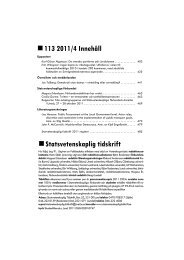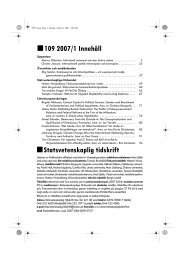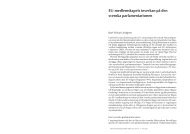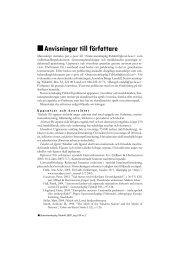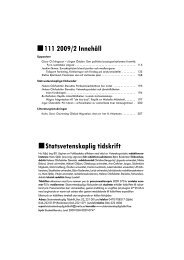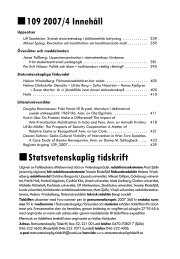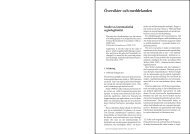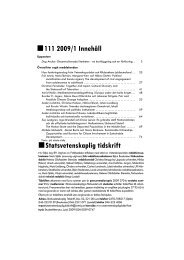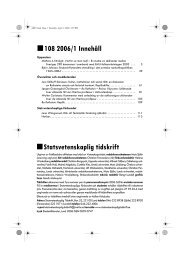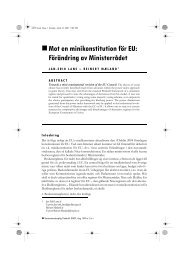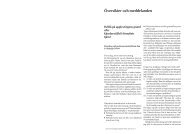Helt nummer 2012/3 (PDF, 1387 kb) - Statsvetenskaplig tidskrift
Helt nummer 2012/3 (PDF, 1387 kb) - Statsvetenskaplig tidskrift
Helt nummer 2012/3 (PDF, 1387 kb) - Statsvetenskaplig tidskrift
Create successful ePaper yourself
Turn your PDF publications into a flip-book with our unique Google optimized e-Paper software.
486 Litteraturgranskningar<br />
achieved through contrasting their values and<br />
attitudes with democratic ideals, but certainly<br />
we can also contrast it with other ideals, such<br />
as authoritarian, romantic or militarized ide-<br />
als. Understanding the transformation of<br />
politics, in particular related to former rebels,<br />
in post-war settings is crucial for facilitat-<br />
ing both peacebuilding and democratization<br />
processes. Here, Professor Lyons and myself<br />
share an interest which I hope we will have<br />
the opportunity to continue to discuss in the<br />
coming years.<br />
References<br />
Blattman, Christopher & Annan, Jeannie,<br />
2009. ”Child combatants in northern<br />
Uganda: reintegration myths and realities”,<br />
p 103–125 in Muggah, Robert (ed), Security<br />
and Post-Conflict Reconstruction: Dealing<br />
with Fighters in the Aftermath of War.<br />
London & New York: Routledge.<br />
Bøås, Morten & Bjørkhaug, Ingunn, 2010.<br />
”DDRed in Liberia: Youth Remarginalisation<br />
or Reintegration?”, MICROCON<br />
Research Working Paper 28.<br />
Greenstein, Lewis J, 1978. ”Impact of Military<br />
Service in World-War-I on Africans – Nandi<br />
of Kenya”, Journal of Modern African Studies,<br />
16(3), p 495–507.<br />
Jennings, M. Kent, & Markus, Gregory, 1977.<br />
”The Effect of Military Service on Political<br />
Attitudes: A Panel Study”, The American<br />
Political Science Review, 71(1), p 131–147.<br />
Kingma, Kees, 2002. ”Demobilization, Reintegration<br />
and Peacebuilding in Africa.” p<br />
181–201 in Newman, Edward & Schnabel,<br />
Albrecht (eds), Recovering from civil conflict:<br />
reconciliation, peace and development.<br />
London & Portland, Or: Frank Cass.<br />
Maclay, Christopher & Özerdem, Alpaslan,<br />
2010. ”’Use’ Them or ’Lose’ Them: Engaging<br />
Liberia’s Disconnected Youth through<br />
Socio-political Integration”, International<br />
Peacekeeping 17(3), p 343–360.<br />
Mitton, Kieran, 2009. ”Engaging with disengagement:<br />
The political reintegration<br />
of Sierra Leone’s Revolutionary United<br />
Front”, in Berdal, Mats & Ucko, David H<br />
(eds), Reintegrating Armed Groups After<br />
Conflict: Politics, violence and transition.<br />
London & New York: Routledge.<br />
Teigen, Jeremy M, 2006. ”Enduring effects of<br />
the uniform: Previous military experience<br />
<strong>Statsvetenskaplig</strong> <strong>tidskrift</strong> · Årgång 114 · <strong>2012</strong> / 3<br />
and voting turnout”, Political Research<br />
Quarterly 59(4), p 601–607.<br />
Johanna Söderström is currently a visiting post-doc<br />
at the Chr. Michelsen Institute (CMI) in Bergen, and<br />
a researcher at the Nordic Africa Institute (NAI) and<br />
the Department of Government, Uppsala University.<br />
E-mail: johanna.soderstrom@statsvet.uu.se.<br />
Engvall, Johan, 2011. The State as<br />
Investment Market: An Analytical<br />
Framework for Interpreting Politics<br />
and Bureaucracy in Kyrgyzstan.<br />
Anmälan av Henry E. Hale<br />
How should we understand the state? This<br />
question has been widely addressed for West-<br />
ern countries, but we know much less about<br />
what it is that we usually call “the state” once<br />
we travel east or south. Johan Engvall has<br />
written and defended an important disser-<br />
tation addressing this question with respect<br />
to Kyrgyzstan, arguing that here and in simi-<br />
lar countries, we can usefully understand the<br />
state as a kind of “investment market”. This<br />
original proposition is sure to advance not<br />
only our understanding of post-communist<br />
transition, but to spark debate among theo-<br />
rists on the nature of the state and how best to<br />
understand the relationship between formal<br />
and informal authority, between states and<br />
markets, and between corruption and transi-<br />
tions from authoritarian to democratic rule.<br />
Engvall begins by noting that standard<br />
treatments of the state found in the theo-<br />
retical literature do not fit well with reality<br />
in Kyrgyzstan, a small remote country bor-<br />
dering China in post-Soviet Central Asia. It<br />
cannot be called a modern state, as recruit-<br />
ment into state offices is clearly not carried<br />
out according to merit. It sits uneasily with<br />
standard descriptions of the Soviet state since<br />
Kyrgyzstan’s state is not all-encompassing.<br />
Examination of African states suggests the<br />
possibility of a “shadow” state dominated by<br />
clan and tribe, but Engvall shows that Kyr-<br />
gyzstan’s state involved far more than this.



